DevSecOps - Kubernetes DevOps & Security
Kubernetes Operations and Security
Demo KubeScan
In this guide, you’ll learn how to deploy OctarineSec KubeScan to continuously assess and monitor Kubernetes workloads. KubeScan computes a risk score between 0 (no risk) and 10 (high risk) for each workload based on configurable runtime rules.
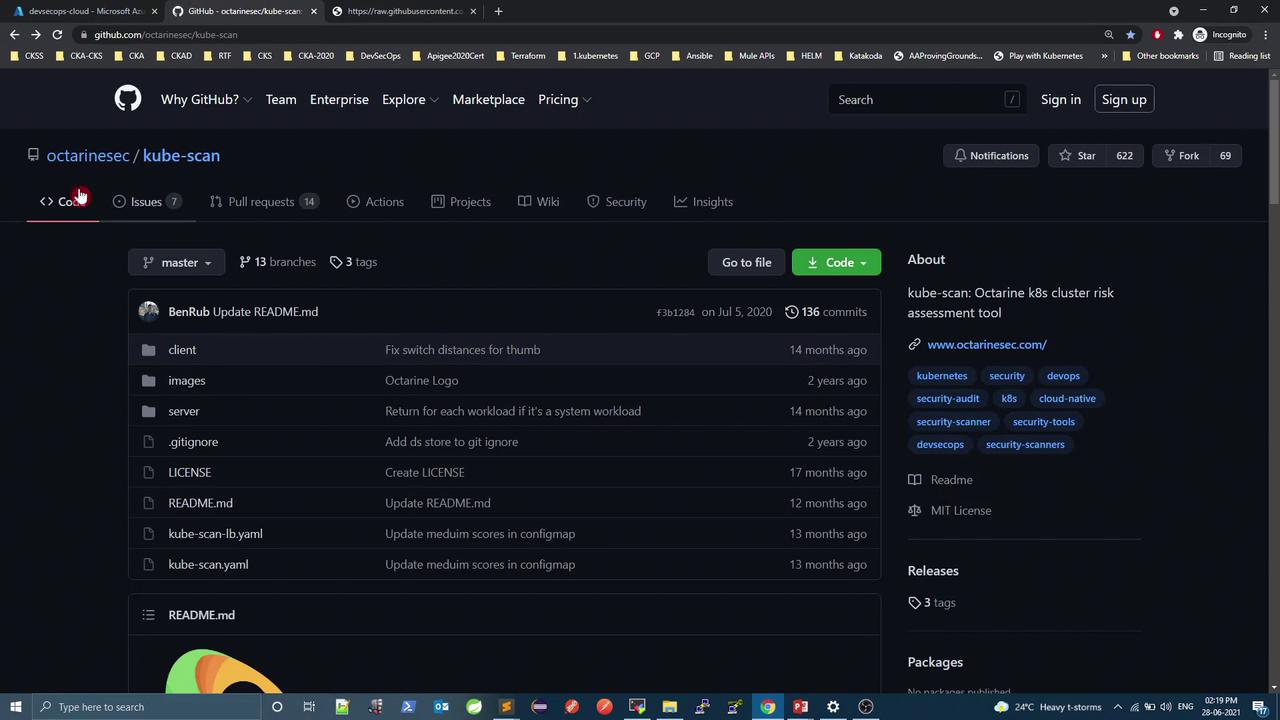
Prerequisites
- A Kubernetes cluster (v1.16+)
kubectlconfigured for your cluster- Docker CLI for building and pushing images
- Git for cloning the repository
1. Clone & Build
Since the official images might not be publicly pullable, clone the source and build both UI and server components:
git clone https://github.com/octarinesec/kube-scan.git
cd kube-scan
# Build the UI client
cd client
docker build -t <YOUR_CLIENT_IMAGE> .
docker push <YOUR_CLIENT_IMAGE>
# Build the server
cd ../server
docker build -t <YOUR_SERVER_IMAGE> .
docker push <YOUR_SERVER_IMAGE>
2. Configure Risk Scoring
Open kube-scan.yaml and locate the ConfigMap under the kube-scan namespace. Adjust thresholds or add rules to match your security policy:
apiVersion: v1
kind: Namespace
metadata:
name: kube-scan
---
apiVersion: v1
kind: ConfigMap
metadata:
name: kube-scan
namespace: kube-scan
data:
risk-config.yaml: |
expConst: 9 # Exploitability weight
impactConst: 3 # Impact weight
low: 3 # Low risk threshold
medium: 5 # Medium risk threshold
max: 10 # Maximum score
basic:
- name: "privileged"
title: "Workload is privileged"
shortDescription: "Privileged containers get full host access"
description: "Privileged containers can compromise host confidentiality."
integrity: "Low"
availability: "Low"
exploitability: "Moderate"
attackVector: "Local"
scope: "Host"
handler: "IsPrivileged"
Note
You can extend basic or create new rule sets for network, resource limits, or Pod security policies.
3. Deploy KubeScan
Update the Deployment spec in kube-scan.yaml to use your built images:
apiVersion: apps/v1
kind: Deployment
metadata:
name: kube-scan
namespace: kube-scan
spec:
template:
spec:
containers:
- name: kube-scan-ui
image: <YOUR_CLIENT_IMAGE>
env:
- name: API_SERVER_PORT
value: "80"
- name: kube-scan
image: <YOUR_SERVER_IMAGE>
env:
- name: KUBESCAN_RISK_CONFIG_FILE_PATH
value: "/etc/kubescan/risk-config.yaml"
volumeMounts:
- name: config
mountPath: /etc/kubescan
volumes:
- name: config
configMap:
name: kube-scan
Apply the complete manifest:
kubectl apply -f kube-scan.yaml
kubectl -n kube-scan get all
4. Expose the UI Service
By default, the UI Service is ClusterIP. To access it externally, switch to LoadBalancer or NodePort:
apiVersion: v1
kind: Service
metadata:
name: kube-scan-ui
namespace: kube-scan
spec:
type: LoadBalancer
selector:
app: kube-scan
ports:
- port: 80
targetPort: 80
protocol: TCP
Reapply and get the external endpoint:
kubectl apply -f kube-scan.yaml
kubectl -n kube-scan get svc kube-scan-ui
5. Access the Dashboard
Open your browser at http://<HOST>:<PORT>. The K8S Risk Assessment dashboard displays all workloads with their risk scores.
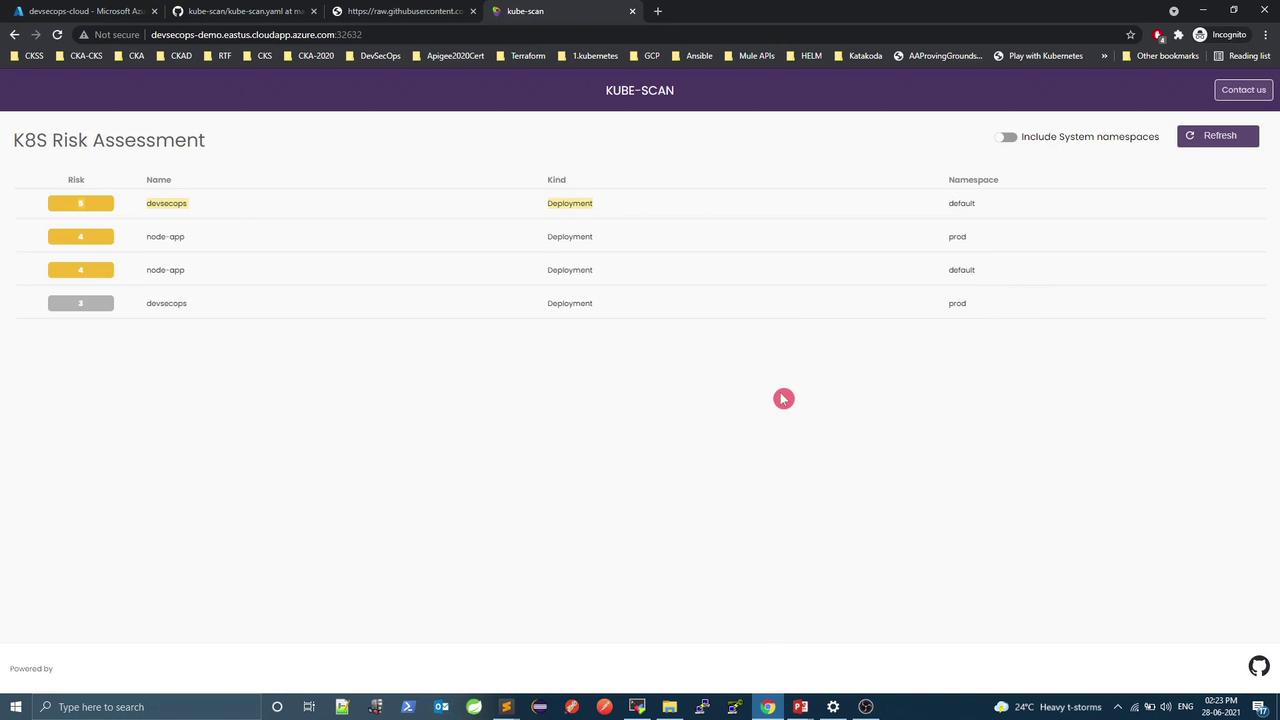
6. Workload Risk Comparison
Compare two deployments of the same DevSecOps application:
| Environment | Risk Score | Security Context | Resource Limits |
|---|---|---|---|
| Default | 5 (Medium) | None | None |
| Production | 3 (Low) | runAsNonRoot, noPrivilegeEscalation, readOnlyRootFilesystem | requests: cpu=200m, memory=256Mi<br>limits: cpu=500m, memory=512Mi |
Default Deployment (Higher Risk)
apiVersion: apps/v1
kind: Deployment
metadata:
name: devsecops
spec:
template:
spec:
containers:
- name: devsecops-container
image: replace
Production Deployment (Lower Risk)
apiVersion: apps/v1
kind: Deployment
metadata:
name: devsecops
namespace: prod
spec:
template:
spec:
containers:
- name: devsecops-container
image: replace
securityContext:
runAsNonRoot: true
allowPrivilegeEscalation: false
readOnlyRootFilesystem: true
resources:
requests:
cpu: "200m"
memory: "256Mi"
limits:
cpu: "500m"
memory: "512Mi"
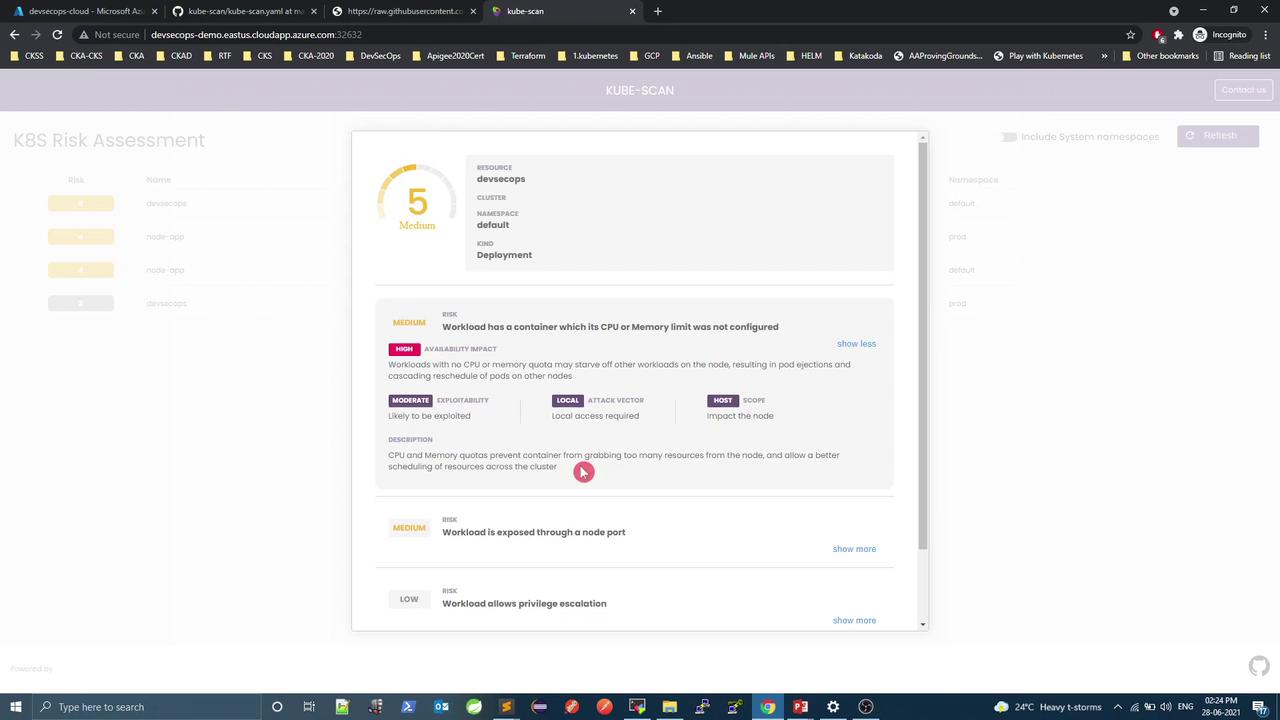
7. System Namespace Pods
Enable “Show system pods” to include core components (e.g., grafana, prometheus) in the assessment.
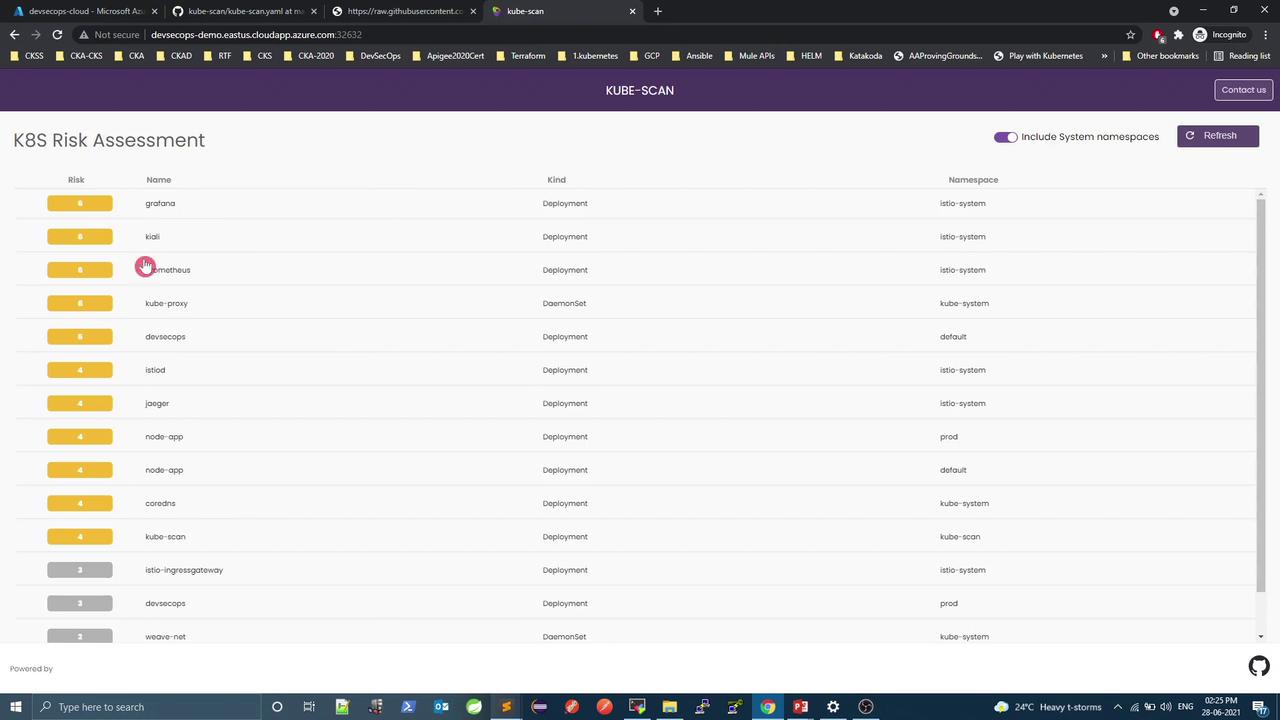
8. Risky Nginx Pod Demo
Create a deliberately risky Pod and Service in both default and prod namespaces:
apiVersion: v1
kind: Pod
metadata:
name: nginx-risky-pod
labels:
run: nginx-risky-pod
spec:
shareProcessNamespace: true
volumes:
- name: vol
hostPath:
path: /etc
containers:
- name: nginx-risky-pod
image: nginx
securityContext:
allowPrivilegeEscalation: true
readOnlyRootFilesystem: false
capabilities:
add: ["ALL"]
volumeMounts:
- name: vol
mountPath: /opt
---
apiVersion: v1
kind: Service
metadata:
name: risky-pod-svc
spec:
selector:
run: nginx-risky-pod
ports:
- port: 80
targetPort: 80
protocol: TCP
Apply and force an immediate scan:
kubectl apply -f risk-pod.yaml
kubectl apply -f risk-pod.yaml -n prod
kubectl -n kube-scan delete pod -l app=kube-scan
- In default,
nginx-risky-podscores 7 (High) due tohostPath,ALLcapabilities, missing limits, and LoadBalancer exposure. - In prod with an Istio sidecar, the score drops to 6 (Medium) thanks to service-mesh encryption and identity features.
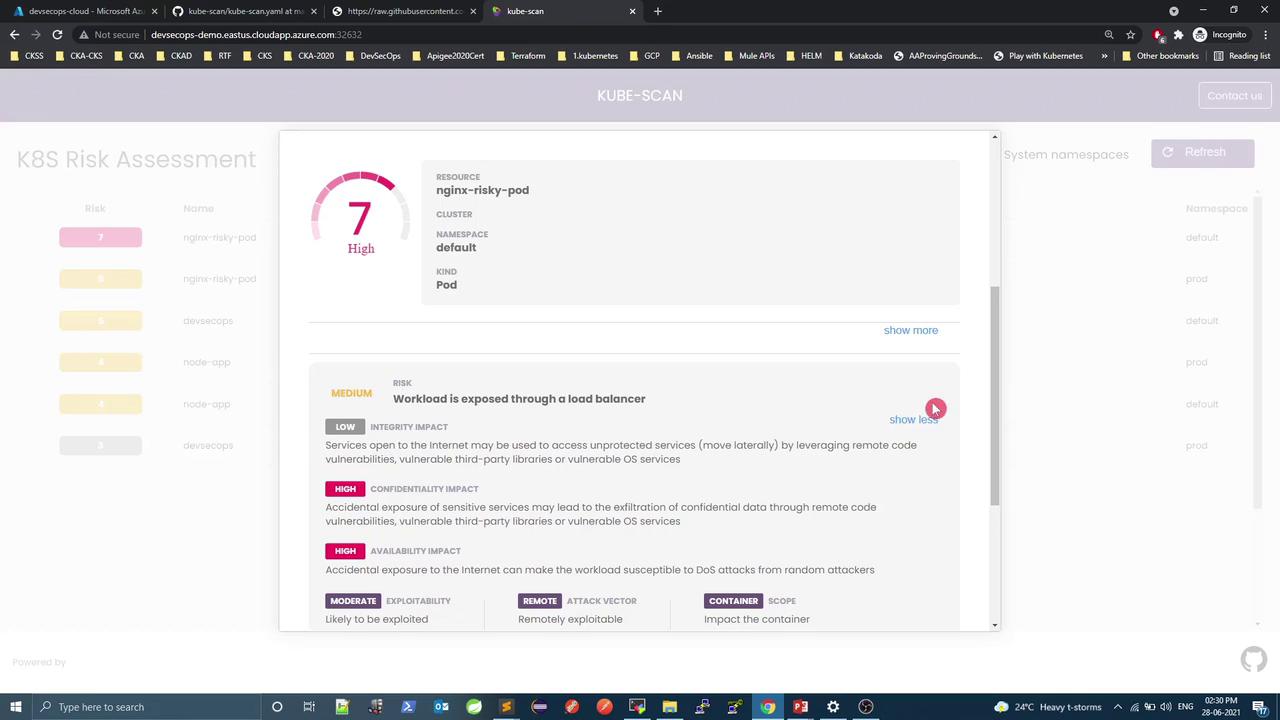
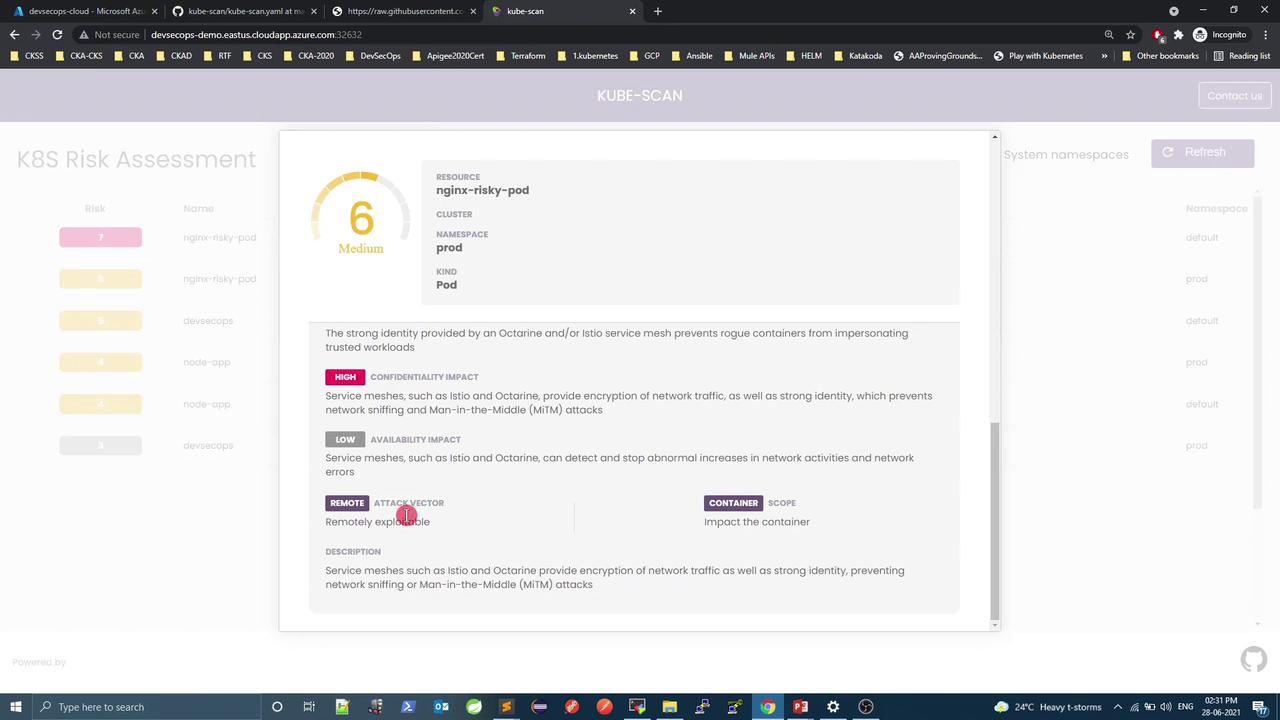
Conclusion
KubeScan provides an automated scoring engine to surface misconfigurations and risk hotspots. By reviewing scores and iteratively adding Pod security contexts, resource constraints, or service meshes, you can drive your cluster toward a more secure posture.
Links and References
Watch Video
Watch video content